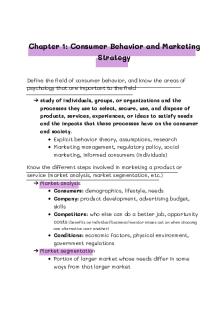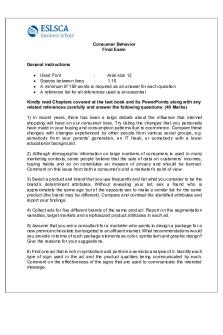2 Symbolic Consumer Behavior PDF

| Title | 2 Symbolic Consumer Behavior |
|---|---|
| Course | Consumer Behavior |
| Institution | Florida State University |
| Pages | 11 |
| File Size | 420.3 KB |
| File Type | |
| Total Downloads | 20 |
| Total Views | 174 |
Summary
Module 4...
Description
2 Symbolic Consumer Behavior Money and Happiness ● Dr Michael Norton ○ Amount: small, large ○ Spending type: prosocial, personal ○ Canada, uganda ● Video: ○ Money can buy happiness ○ Cnn article: People who win lotto because spend all their money and go into debt, and people start reaching out to them and it ruins their relationships ○ People started commenting on article what they would do ■ Realized it made people antisocial and selfish ○ When people spent more money on more people; making people prosocial and make others spend on their self and see who was happier ○ Asked people at british columbia university to be in experiment and if they said yes gave a slip of paper and $ that said “spend this $ on yourself” or “spend this $ on someone else” ■ Self: bill, expense, gift, etc ■ Other: charitable donation, gift for others etc ■ Gave people either 5 or 20 dollars at random ○ Called at night to ask what they spent on ■ Self: jewelry, makeup, coffee ■ Prosocial: teddy bears, homeless, coffee ● Spending on same thing (coffee) but targeted different ○ Then asked how they felt at end of day ■ Self: no effect ■ Prosocial: felt happier at end of day ○ Amount of money- people thought that the $20 would feel better ■ Does not feel better to spend more- same effect ○ Tried this in uganda as well- same experiment ○ Similarities: ■ Spend money on other people with maybe something in mind or not ■ Date ○ Differences: ■ Canada: present for mom ■ Uganda: gave money for medical donation for old friend’s child with malaria ● Findings: does not matter how important what you spend money on for someone else- still has same effect ○ 136 countries- people who donate to charity positive correlation with happiness ○ Into companies (sales teams)- gave money and say spend how you want or tell them to spend on a teammate (prosocial team) ■ One team pooled and made a pinata
■ Think of the bonding activity rather than putting in own pocket ■ Personal incentive- lose money ■ Prosocial incentive- actually gain money ○ Dodgeball team- same winning percentage if gave money for self, and teams that were prosocial bonded, excelled and dominated league ○ Should give money to people! Woohoo! Model of Gift Giving Process **Know this **
● ● ● ● ● ● ●
Nature of the gift- necklace - sits on neck, very close and personal Value- complexity around how recipient perceives value- monetary value vs non Search time- sense of urgency, more time= more careful, throughout purchase Ceremony- unwrapping Presentation- public vs private etc Reformulation- what happens now/ how does giving this gift affect relationship between the two Gestation Stage: Gifts and Teenagers ● 11-16 year old boys and girls: ○ Recall giving: a gift in the last year to a peer, a second different gift giving situation, a gift situation that went bad ● identity/ social roles ○ Social: joint gifts, joint consumption (music CD) ○ Individual: self-[aid, independent selection ● Impression management: ○ Branded products Gestation Stage: Gift Cards ● Motives:
○ ○
Reducing social risks Weak social relationships between givers and recipients → givers more concerned about meeting their own social needs than their recipients’ needs ■ Signals you don't have close relationship Charitable Giving ● Have you ever donated to a charity? Reformulation Stage:Thank you gifts in response to Charitable Giving ● Peoples predictions: ○ Thank you gifts → increase donations ● Actual behavior: ○ Thank you gifts appear to actually reduce donations ○ Documented across different charities, different gifts
● ●
Findings: ○ People gave less when there was a donation gift ● Due to: ○ Anchoring and adjustment- when ppl are given a gift from a charity, people anchor what they give to charity, charities work on small budget, assume they can just go in store and buy so anchor up ○ If no gift involved then people use other points of reference how much to donate ○ Intrinsic motivation- more pure donation, when gift becomes part of it it sullies it making it an exchange Sources/ Functions of Symbolic Meaning ● Derived from culture ○ Categories (e.g. time, clothing) ○ Principles (e.g. work time/ leisure time, work clothes/ leisure clothes) ● Derived from consumer ○ Symbols used to say something ○ Consumer as a member of group or a unique individual Romantic Consumption Defined ● Romantic consumption- the consumption of offerings that evoke romantic feelings and thoughts on a frequent basis
●
Examples: reading romantic books, watching romantic movies, and assuming romantic roles in video games, using dating services, investing in honeymoons and weddings Why Romantic Consumption ● Big business ● Romantic dating- $2 Bil industry ● Business implications related to romantic consumption Attachment Styles ● Consumers have different romantic attachment styles; ○ When we think about forming relationships (any) our relationships in some part are driven by attachment styles living on 2 dimensions ■ Anxiety (low or high)- how needy you are in relationship, do you want more than the other person, etc- as someone comes higher on dimension, they are more anxiously attached ■ Relationship avoidance (high or low)- don't want to be hurt by person, person ask something of you you cannot do because don't want to get hurt ■ When intersects creates 4 quadrants
■ ■ Know this^ ■ Secure, anxious, fearful, avoidant ■ How these styles spend money on this based on attachment relationship Attachment Styles and Romantic Movies ● Romantic movie trailer ● Paper man
○ ○
People who are securely attached were interested in watching the rest of the movie- after watching trailer and being asked how interested in watching ○ Statistically people who were anxious and fearful were not different in terms of interest in consuming product- watching rest off movie ○ People who were avoidant, were statistically significantly lower in their stated interest in stated interest in watching the rest of the movie ○ Indicator that peoples romantic attachment styles predict how interested they were in something (romantic like a movie) ■ Important bc movie industry is multibillion dollar industry ■ Can help shape marketing targets Types of Romantic Love ● Companionate love
●
○ ○ Lasting love ○ Intertwined wedding bands etc ○ All were into it besides avoidant Passionate love
○ ○
●
See heart with flames on bottom instead of flames but otherwise website is flames ○ passion= works with the avoidant people Motive for emotional intimacy was something driving for all
● Implications for Managers ● How attachment styles affect managerially relevant outcomes related to romantic consumption ○ (consumer choice, purchases, intentions, interests in a new product, responses to ads, spending) in a variety of context (e.g. romantic gaming, movies, fragrances, books, greeting cards, online dating, weddings) ● Segmenting consumers ○ Measure attachment styles to better segment their target markets ○ Anxious and fearful consumers emulate secure consumers ○ Avoidant segment can be targeted more effectively with passionate love ● Position products that are non-romantic with romantic love themes (e.g. Nescafe Gold Blend, KFC’s “love is forever”, coca-colas “love is in the air”) Sources and Functions of Consumption Symbols
● ● ● ●
Good to know How using a particular product defines you (group or individual) Expressiveness- use of products to demonstrate our uniqueness from other ○ Fashion, car, home, etc ○ The rock- tribal tattoos- who he is as an individual ● Connectedness- collection of concert ticket stubs that help you connect to those memories and the people who joined you ○ Highlights group membership that you had that you feel is special ● Role acquisition- e.g. a new briefcase could help an individual transaction from college to the working world, and feel more comfortable in our new role ● Emblematic- a sweatshirt with your sororities greek letters indicates to others that you are a member Emblematic Function ● Geographic emblems ○ Products can symbolise geographic identification ○ Eg. preppy clothing style symbolizes identification with New England ● Ethnic emblems ○ Products and consumption activities can symbolize identiffication with a given culture or subculture ○ Clothing and food are used to express ethnic identitiy ○ Consumers sometimes use ethnic emblems of other cultures to differentiate themselves ● Social class emblems ○ Products we consumer reflect our social class ○ Social classes use different symbols in consumption rituals ● Gender emblems ○ Products seem to be characterized as having membership in the male or female gender category ● Reference group emblems ○ Products such as school uniforms can serve as emblems ○ Rituals such as debutante balls are sometimes indicators or affirmations of membership Establishing Emblematic Function ● Symbol development ○ Identifies cultural principles associated with a cultural category and imbues the
product with attributes deemed to represent those characteristics Symbol communication ○ Advertising can imbue a product with meaning through the selection of setting, time of day, types of people in the ad, and how the product is presented ● Symbol reinforcement ○ Other marketing mix elements are designed to reinforce the symbolic image ● Symbol removal ○ Some marketers help consumer erase symbols associated with groups with whom they no longer identity ■ “Delete” in boston- tattoo removal service - “move on, delete your old flame” Role Acquisition Function ● Phases ○ Separation- often involves disposing of products associated with the role we are leaving behind ■ Throwing away single person items when entering new relationship ○ Transition- marked by experimentation with new identities ■ Matching couple t-shirts? How far are we taking this? ○ Incorporation- taking on the new role and the identity associated with it ● symbols/ rituals: ○ Reflexive evaluation: getting positive acceptance from aspirational group members ● Marital ● Cultural ○ Immigrants? Expatriates? ● Social status- consumers who newly come into money may ostentatiously spend to demonstrate and validate their new role Model of Role Acquisition (good to know) ●
● ●
Transition- away from being a student ○ Briefcase?, backpack? Etc ● People giving us social approval so we know if we are being accepted and boosting our confidence Other Symbolic Functions ● Connectedness ○ The use of products as symbols our personal connections to significant people, events or experiences ● Expressiveness ○ The use of products to demonstrate our uniqueness from others ● Multiple functions ● Symbols and self- concept: identity schemas ○ Actual ○ Ideal Marketing/ Development off Consumer Self- Concepts ● Product fit with self- concept ● Product fit with multiple self- concepts ● Advertising fit with self concepts Types of Special Possessions ● Pets ● Memory-laden objects ○ Souvenirs, photos ● Achievement symbols ○ Plaques, trophies ● Collections Characteristics of Special Possessions ● Not sold at market value
● few/ no substitutes ● Not discarded ● Not always used for original purpose ● Evoke powerful emotions ● Frequently personified Why Are Some Products Special? ● Symbolic value ○ Fulfill the emblematic, role adoption, connectedness, and expressiveness functions ● Mood- altering properties ○ Can evoke feelings of pride, joy and comfort ● instrumental/ utilitarian importance ○ Extremely useful in some way ● Consumer characteristics influence what is special: ○ Social class ○ Gender ■ Men: products that symbolize activity and physical achievement (agentic) ■ Women: products that symbolize their attachment to other people (communal) ○ Age Rituals Used With Special Possessions ● Possession ○ Enable consumers to claim personal possession of new goods. ○ Eg. personalized plates, build- a bear ● Grooming ○ Caring for product in a special way ○ Eg. dads special classic car from high school “glory days” ● Divestment ○ Eg. removing address from used magazine beforing sharing them ● Disposing ○ To mark rites of passage and progression ○ Often given to close friends and family in the hope that the meaning of the possession is transferred to recipient ○ Eg. grandmothers ring, grandfathers watch Sacred Meaning ● Sacred entities: great respect ● Profane things: ordinary/ mundane ● People, objects, and places ● Characteristics ○ Involve mystery/ myth ○ Strong approach/ avoidance; feeling of power ○ scarcity/ exclusivity ■ Religion, america and bald eagle etc. ● How profaned
○ ○
Treated with disrespect Commercialized ■ Ex: the goods- trying to sell used cars by pulling at heartstrings of consumers- american flag, draw them in, commercializing what customers see as sacred- treating with disrespect to exploit consumers...
Similar Free PDFs

2 Symbolic Consumer Behavior
- 11 Pages

Consumer behavior séance 2
- 5 Pages

Consumer behavior
- 5 Pages

Consumer Behavior
- 33 Pages

Lecture 6 Consumer Behavior
- 2 Pages

Consumer Behavior Final Exam
- 2 Pages

MCQs-Consumer-Behavior
- 24 Pages

Consumer Behavior quiz
- 1 Pages

Case Study Consumer Behavior
- 3 Pages

Jada May - consumer behavior
- 5 Pages

Readings Summary - Consumer Behavior
- 62 Pages

Final Report Consumer Behavior
- 19 Pages

Consumer Buying Behavior
- 3 Pages

Chapter 4 - Consumer Behavior
- 8 Pages

Consumer Behavior Coffee Vietnamese
- 16 Pages
Popular Institutions
- Tinajero National High School - Annex
- Politeknik Caltex Riau
- Yokohama City University
- SGT University
- University of Al-Qadisiyah
- Divine Word College of Vigan
- Techniek College Rotterdam
- Universidade de Santiago
- Universiti Teknologi MARA Cawangan Johor Kampus Pasir Gudang
- Poltekkes Kemenkes Yogyakarta
- Baguio City National High School
- Colegio san marcos
- preparatoria uno
- Centro de Bachillerato Tecnológico Industrial y de Servicios No. 107
- Dalian Maritime University
- Quang Trung Secondary School
- Colegio Tecnológico en Informática
- Corporación Regional de Educación Superior
- Grupo CEDVA
- Dar Al Uloom University
- Centro de Estudios Preuniversitarios de la Universidad Nacional de Ingeniería
- 上智大学
- Aakash International School, Nuna Majara
- San Felipe Neri Catholic School
- Kang Chiao International School - New Taipei City
- Misamis Occidental National High School
- Institución Educativa Escuela Normal Juan Ladrilleros
- Kolehiyo ng Pantukan
- Batanes State College
- Instituto Continental
- Sekolah Menengah Kejuruan Kesehatan Kaltara (Tarakan)
- Colegio de La Inmaculada Concepcion - Cebu
